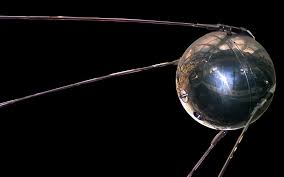October 4, 1957: The Launch of Sputnik I and the Dawn of the Space Age
On October 4, 1957, the Soviet Union launched Sputnik I, the first artificial satellite to orbit the Earth, marking the official beginning of the Space Age. This historic moment revolutionized space exploration and sent shockwaves through the global political and scientific communities, particularly in the United States. Weighing just 184 pounds, Sputnik I transmitted a simple beeping radio signal back to Earth for 21 days, but its impact resonated far beyond its modest size and short lifespan.
What Was Sputnik I?
Sputnik I was a small, spherical satellite measuring just 23 inches in diameter, equipped with four external radio antennas to broadcast its iconic beeping signal. Launched aboard an R-7 rocket from the Baikonur Cosmodrome in Kazakhstan, it was the first man-made object to reach space and successfully orbit the Earth. Sputnik’s signals were detectable by radio operators all around the world, serving as a tangible reminder of Soviet scientific prowess.
While the satellite’s design was simple, its significance was enormous. The successful launch of Sputnik I demonstrated that the Soviet Union had developed the technology to send objects into space, creating concerns about the potential for long-range missile capabilities. This technological breakthrough ignited a new chapter in the Cold War, with the U.S. and the Soviet Union racing to dominate space.
The Space Race: America’s Response to Sputnik
The launch of Sputnik I sent shockwaves through the American political leadership, as it was seen as a critical Soviet victory in the Cold War. Until this point, the United States had assumed technological superiority over the Soviet Union, particularly in missile and space capabilities. Sputnik’s success challenged that notion and led to widespread fear that the U.S. was falling behind.
This fear was compounded by the broader geopolitical implications: if the Soviet Union could launch a satellite into orbit, it meant they had the capability to develop intercontinental ballistic missiles (ICBMs) that could potentially carry nuclear warheads to U.S. soil.
In response, the U.S. government quickly ramped up its own space efforts. President Dwight D. Eisenhower established the National Aeronautics and Space Administration (NASA) in 1958, marking a critical step in America’s entry into the Space Race. The competition to achieve space superiority was not only about technological and military dominance but also about national pride. This rivalry would eventually culminate in the United States landing the first humans on the moon in 1969, a direct outcome of the competition spurred by Sputnik’s launch.
The Technological and Scientific Impact of Sputnik I
Beyond its political ramifications, Sputnik I represented a major leap forward in science and technology. It marked humanity’s first step into space, opening up endless possibilities for space exploration, satellite communication, and scientific research. The satellite orbited the Earth for three months before re-entering the atmosphere and burning up on January 4, 1958.
Sputnik’s beeping radio signal, transmitted at 20.005 and 40.002 MHz frequencies, was simple but symbolic, proving that satellites could communicate with Earth-based receivers. This breakthrough paved the way for subsequent advancements in satellite technology, which today enable everything from GPS navigation to global telecommunications and weather forecasting.
Sputnik and Education Reform in the U.S.
The launch of Sputnik I also had a profound impact on education in the United States. Concerned about the perceived gap in scientific knowledge between the U.S. and the Soviet Union, American leaders called for a major overhaul of the education system, particularly in science, technology, engineering, and mathematics (STEM) fields. This led to the passage of the National Defense Education Act (NDEA) in 1958, which provided federal funding to improve education in these areas.
The emphasis on STEM education laid the groundwork for future generations of scientists, engineers, and astronauts, ensuring that the U.S. would remain competitive in the Space Race and beyond.
The Legacy of Sputnik I and the Space Age
Sputnik I’s launch on October 4, 1957, marked the beginning of a new era—the Space Age—that would change the world forever. It demonstrated that humanity could reach beyond the confines of Earth and explore the cosmos. The Space Race that followed not only led to the historic Apollo 11 moon landing but also inspired countless technological advancements in fields such as aerospace, medicine, and computing.
The beeping signal of Sputnik I may have only lasted 21 days, but its legacy continues to echo through the corridors of history. The satellite’s launch proved the power of human ingenuity and set the stage for the incredible space exploration feats we continue to witness today.
Tags:
Sputnik I, Space Age, October 4, 1957, first satellite in space, Soviet satellite Sputnik, history of space exploration, Sputnik launch impact, Cold War Space Race, U.S. response to Sputnik, NASA founding, technological impact of Sputnik, first satellite orbiting Earth.
Meta Description:
"On October 4, 1957, the Soviet Union launched Sputnik I, the world’s first artificial satellite, marking the beginning of the Space Age. Learn how this historic event sparked the Space Race and reshaped global science and technology."











0 $type={blogger}:
Post a Comment
Your valuable comment push here